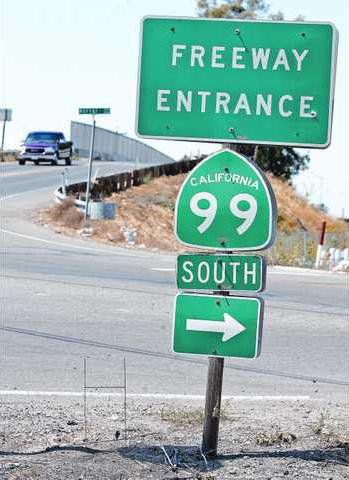It is an expenditure of $60,100 with potentially far-reaching consequences.
The Manteca City Council when they meet today at 4 p.m. – three hours ahead of usual so elected leaders can attend National Night Out parties – are being asked to approve an agreement with the San Joaquin Council of Governments. It is project management services for a future replacement interchange for Austin Road along Highway 99.
Some 15,000 jobs plus the possibility of relocating a controversial alignment of McKinley Avenue even farther south into rural farmland may be at stake. It also could start the initial step in a long journey of Manteca and Ripon working together to settle on one major interchange between Jack Tone Road and the 120 Bypass to handle future growth in both cities. That journey would also mean the state could one day move ahead with possibly increasing the number of 120 lanes merging into southbound Highway 99 to ease a perennial traffic back-up on the Bypass that occurs during commute hours and at various times throughout the day.
As in all such planning matters, city leaders caution they are only talking about exploring a new design and location for a future interchange. But in reality, that interchange is the linchpin for major planning and growth initiatives that run from the edge of current day City of Ripon east of Olive Avenue to McKinley Avenue in west Manteca as well as the job rich potential of Austin Road Business Park in between.
Any relocation of the interchange would mean rethinking circulation patterns and possibly even generally adopted development patterns.
The city several years ago had started working on plans for a replacement interchange for Austin Road when Caltrans told them the existing interchange was too close to the 120 Bypass ramps to be expanded. Caltrans has a rule of a mile separation between interchanges which is one reason why the possibility of adding more ramps to Highway 99 from the eastbound 120 Bypass isn’t feasible at the current time. The merging movement of the current Austin Road ramps and the 120 Bypass are too close to meet minimum safety standards now in place.
Experts designed a $150 million double bridge interchange crossing both the Highway 99 freeway and Union Pacific railroad tracks. It was that pricey due in part to the perceived requirement that the freeway had to be shifted to the east to make it work.
Recently, the Caltrans policy was clarified. It is actually two miles separation between a major highway interchange and a surface street and a mile separation between surface street interchanges on freeways.
That derails both Manteca’s plans for Austin Road as well as Ripon’s plans for an Olive Avenue interchange. Manteca has already adopted specific zoning within the massive 1,049-acre Austin Road Business Park based on placement of the replacement interchange. Ripon also made some planning assumptions based on where the Olive Avenue interchange would go and how it would tie into Manteca traffic flows.
At the same time, Manteca unveiled a planning corridor for the future extension of McKinley Avenue to tie into the new Austin Road interchange to create an arterial connecting with the 120 Bypass via an interchange the city is trying to move forward on building at McKinley Avenue.
City Manager Karen McLaughlin noted that the new interchange study could impact plans for McKinley Avenue. And while the McKinley Avenue extension as a reality could be 20 plus years away, whatever alignment plan the city adopts now will dictate what happens in the future in terms of where growth occurs.
The future extent of growth toward the Stanislaus River has been a concern voiced repeatedly by rural residents south of Manteca.
McLaughlin said ultimately a number of things could happen. The McKinley Avenue alignment corridor might stay where it is at with a “frontage road” or a connector street to the new interchange. The alignment corridor could move farther south to align with the new interchange. The city could also back off a McKinley Avenue extension as envisioned and put more emphasis on Atherton Drive to move traffic. The last scenario, though, is highly unlikely considering the city has noted that spreading the cost - and “benefit” - of the McKinley Avenue interchange as wide as possible would make the project more cost effective and financially feasible to build.
While a decision may still be a few years out on McKinley Avenue whatever happens with the new interchange will have an impact on that process.
Meanwhile, the SJCOG staff member that will be doing the work for the city is a former Caltrans employee with interchange design experience. The city has been told an interchange design could be developed that would not require shifting the freeway. That would reduce the cost somewhat.
McLaughlin said the city doesn’t have a funding source for the actual interchange construction yet secured. The goal is to have a plan in place to move on when funding is obtained.
Meanwhile, the city is going through with preliminary work for modifications to the existing Austin Road interchange to accommodate initial development of the business park. That may involve widening or reworking ramps, traffic signals and restriping the overcrossing.
Both the developer and city have indicated from the way the Austin Road Business Park is designed, the number of available paper lots in Manteca for future homes, and the market in general that the business park would be the first of the 1,049 acres to develop.
Change in interchange plans
Caltrans rule impacts Ripon, Manteca & rural residents





